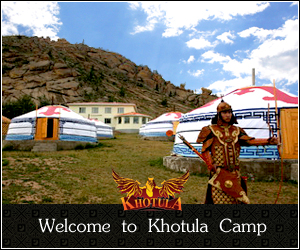Gobi Desert
 The Gobi Desert is in the heart of Mongolia and is the destination of many who really want to experience Mongolia. It is the habitat of the rarest animals and a unique natural landscape. . Maybe it’s the vast, empty space, the incredible colors, or the way the expanses make a traveler focus their attention on nothing but the land before them. The Gobi, which is subdivided into thirty-three regions such as Galba, Borzon, Zag and Suuj, Sharga, Nomin, and Beyond Altai, covers 30 per cent of the country and stretching from the east to the west through the southern part of Mongolia. The Gobi is an endless vast steppe with mirage that hallucinates objects, fine golden sand dunes and many other unusual phenomena.
The Gobi Desert is in the heart of Mongolia and is the destination of many who really want to experience Mongolia. It is the habitat of the rarest animals and a unique natural landscape. . Maybe it’s the vast, empty space, the incredible colors, or the way the expanses make a traveler focus their attention on nothing but the land before them. The Gobi, which is subdivided into thirty-three regions such as Galba, Borzon, Zag and Suuj, Sharga, Nomin, and Beyond Altai, covers 30 per cent of the country and stretching from the east to the west through the southern part of Mongolia. The Gobi is an endless vast steppe with mirage that hallucinates objects, fine golden sand dunes and many other unusual phenomena.
You will hear the cry of baby camels that are outside the scattered ger-yurts only in the Gobi. Many of the paleontological findings have been found in the Gobi. It houses numerous endangered animals, such as the wild ass, wild camel, saiga, and Gobi bear, that are recorded in the World Red Book.
There are also places with little woods of saxaul and elm and streams which are called oasises. At oasises or animal heavens, all the animals of the surrounding area gather. Its numeral rare animal species include argali sheep, ibex, snow leopard, lynx, wild ass, gazelles, saiga, wild, wild bactrian camel and Gobi bear, just to name a few. While traveling trough Mongolian Gobi Desert you can visit following highlights:
 Gobi Gurvan Saikhan or Three Beautiful mountains
Gobi Gurvan Saikhan or Three Beautiful mountains
It is a 100km range that consists of three separate ranges, West, Middle, and East, consisting of Devonian Paleozoic sedimentary rocks like chert. It goes through the territory of Umnugobi province. The highest peak is East Beautiful, 2800m, which is close to Dalanzadgad. It also embodies the Protected area Yol valley. In the West Beautiful mountain, there is a spot with an exposed mantle rock of Silurian period (400 million years ago).
The Gobi Gurvan Saikhan National Park features some of the most popular tourist destinations including the picturesque gorge of Eagle valley, and the Singing Sands, a spectacular sea of sand dunes bordered by red sandstone formations, an oasis and a saxaul forest. The Nemegt, Hermen Tsav, and Bayanzag flaming cliffs, the sites of numerous important dinosaur fossil discoveries, also lie within the park.
Eagle Valley
One of the best-known travel destinations in the Southern Gobi is Yoliin Am canyon, known as Eagle valley.
But in fact, Yol means Lammergeyer, one of the most endangered bird species of prey. Through the canyon, which is nestled between ridges of Zuun Saikhan Uul mountain, park of the Gobi Gurvan Saikhan National Park, small river flows. Sheltered by high cliff walls on both sides of the canyon, thick ice gorges remain frozen even on summer’s hottest days.
“Bayanzag“ The Flaming Cliffs
First discovered by Roy Chapman Andrews, famous American explorer in the 1920, flaming cliffs of Bayanzag are an important site for both archaeological and paleontological findings. Complete dinosaur and Egg-thief and numerous eggs were excavated in ravines between the red flaming cliffs, which look like fire in the middle of the desert from distance.
 Hongor Els Sand Dunes
Hongor Els Sand Dunes
Hongor Els sand dunes, the largest sea of sand stretch for 180 km. The widths of the sand stretch exceed several miles and highest peaks tower up to over 250 feet. At the northern edge of the dunes one bank of Hongoriin gol river, there is an oasis, which is rich in plantation and supports drinking water of animal species in the region.
Ongiin River and Temple
The site of the Ongiin River, where the ruins of Ongiin Temple stand is the half way point between the two major travel destinations – the South Gobi and Karakorum. A number of travelers tend to spend a night on this spot in this area, during their journey between the southern Gobi desert and Central Mongolia.
Great Gobi Protected Area
The Great Gobi Protected Area, covering 5.3 million hectares is the largest natural reserve in Asia and the third largest in the world. Great Gobi reserve protects a largely undisturbed part of the vast Gobi desert, and provides a last refuge for representatives of the ancient terrestrial fauna of Central Asia. The protected area is divided into two ecologically distinct parts, the Southern Altai Gobi (Gobi Altai) and the Dzungarian Gobi (Gobi Altai) separated by some 300 km.













Hello just thought i would certainly let you know one thing.. It is 2 times today i’ve landed on the website in the last 3 days looking for totally unrelated things. Spooky or what?